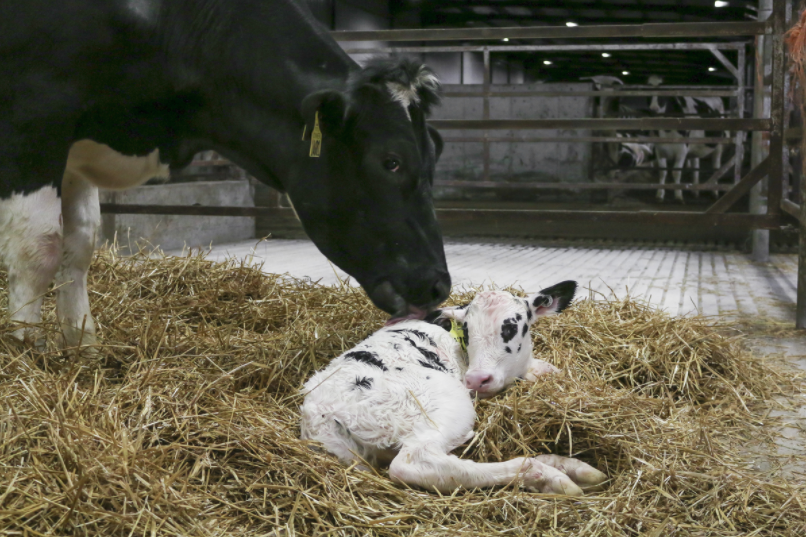Fortunately, studies have shown that the number of cows affected with milk fever (clinical hypocalcemia) has been declining over the past few decades, with 2.5% of cows affected in the first 72 hours after calving. Yet a recent finding shows the high level of subclinical hypocalcemia found on farms might be a cause for concern.
When cows do not show signs of milk fever but have low levels of calcium in their blood, they are experiencing subclinical hypocalcemia. Approximately 25% of cows in their first lactation and 50% of cows in their second or greater lactation may be affected.
Why does it occur?
Calcium is an essential mineral involved in the function of several different tissues and physiologic processes, including muscle contraction. In late gestation, cows typically have all the calcium they need, as it’s primarily for maintenance of body tissues and development of the calf skeleton at this stage. However, at the beginning of lactation, the cow’s body experiences a huge demand for calcium particularly because colostrum is very high in calcium. In fact, cows’ demands for calcium change from about 10 grams per day for late fetal growth to 30 to 50 grams per day in early lactation, which leads to the demand for calcium exceeding the ability of the cow’s body to absorb calcium from bone or its diet. This imbalance is the major reason why we see very high levels of subclinical hypocalcemia.
Who is at risk?
The higher the lactation the cows are in, the greater the risk, with cows in first lactation having the lowest rate of subclinical and clinical hypocalcemia. Breed also plays a role; Jerseys are more likely to experience hypocalcemia compared to Holsteins. Some studies have also found cows experiencing lameness may be at higher risk of hypocalcemia. This is probably a result of the additional feed intake issues facing lame cows, as they tend to visit the feedbunk less frequently than non-lame cows.
What are the consequences?
There are many consequences that occur as a result of hypocalcemia, but they differ depending on whether a cow is clinically or subclinically affected.
Clinical hypocalcemia is considered a gateway disorder, meaning it is a risk factor for many transition diseases including dystocia, uterine prolapse, retained placenta, metritis, displaced abomasum, ketosis and mastitis. A clinical case of milk fever also reduces milk production and increases the likelihood of being culled.
Subclinical hypocalcemia can result in significant consequences as well. Cows with subclinical hypocalcemia at two to four days in milk (DIM) have a greater risk of metritis and a displaced abomasum. In addition, second-lactation-or-greater cows with subclinical hypocalcemia at four DIM have been shown to have decreased milk production.
Some of these consequences could occur due to reduced immune function. Specifically, cows with hypocalcemia will have reduced neutrophil (a type of white blood cell) function, which is critical in controlling inflammation and responding to infectious disease. This immunosuppression is one reason hypocalcemia is associated with retained placenta, metritis and mastitis.
Can we treat it to minimize the impact?
For clinical hypocalcemia, treatment depends on what signs the cows are exhibiting. Early signs of clinical hypocalcemia, or stage 1, include wobbliness or ataxia, weight-shifting, dull appearance, cold extremities and reduced rumen contractions, but the cow will still be standing. Stage 1 hypocalcemia is best treated with oral calcium. IV calcium is not recommended in cases when cows are standing, as it can lead to complications that can increase the risk of death – but more commonly, it causes a large spike in calcium followed by a significant rebound drop in calcium. This is due to cows excreting a higher amount of calcium and not absorbing as much calcium from bone. All this is to say, if a cow is standing and showing early signs of hypocalcemia, IV calcium should not be given; oral supplements are the preferred treatment.
For cows in stage 2 or 3 of hypocalcemia, where cows are down, IV calcium is needed as soon as possible, as irreversible muscle damage can occur quickly. The most appropriate dose is to provide one bottle intravenously. Providing two or more bottles of IV calcium is not warranted, as it will increase the risk of relapse of hypocalcemia and death.
Treating subclinical hypocalcemia is trickier because we are not currently able to identify cows in a practical manner (i.e., a cowside blood test). Therefore, prevention is the best practice.
Strategies to prevent hypocalcemia
Focusing on providing a well-balanced ration before calving and supplementation of calcium after calving are the major strategies used to prevent hypocalcemia. It is important to note that most of the strategies discussed below are shown to be effective in preventing clinical hypocalcemia, but more research is needed to explore avenues to prevent subclinical hypocalcemia risk.
Nutritional strategies
Feeding a low-calcium diet in the dry cow period helps create a calcium deficit, which can better set up the cow’s body to naturally produce calcium to respond to the demands of lactation after calving. To have this benefit, cows need to consume less than 20 grams of calcium per day, which can be extremely challenging. Therefore, the use of calcium binders can be used to bind calcium in the rumen and mimic feeding a diet low in calcium. Using these calcium binders for two to three weeks prior to calving results in increased blood calcium levels after calving, leading to a lower level of subclinical and clinical hypocalcemia. These calcium binders certainly have benefits; however, more work is needed to understand the optimal length of time to supplement and the long-term effects on health and performance.
Negative dietary cation anion difference or DCAD diets fed three weeks before calving have been used as a way to minimize hypocalcemia after calving. The way this type of diet works is: It creates a mild level of acidosis, which allows for increased absorption of calcium from bone and reduced excretion of calcium in urine. Feeding a DCAD diet has been shown to reduce clinical and subclinical hypocalcemia as well as retained placenta and metritis. To ensure the effectiveness of the DCAD diet in causing mild metabolic acidosis, urine pH needs to be monitored. Consult with your nutritionist to develop an effective DCAD diet.
Calcium supplementation after calving
With a supplementation strategy, the goal is to provide cows with an immediate source of calcium that covers the time between the start of lactation until calcium demands decrease, which can be done with the use of an oral calcium bolus.
The use of oral calcium supplementation requires targeted supplementation to have the greatest benefit. Multiparous cows that are lame or had previous lactations with very high levels of production are among those that benefit most from calcium boluses soon after calving. Specific benefits when using an oral bolus in this group include a reduced risk of subclinical hypocalcemia, lower risk of mastitis in the first 60 DIM, improved milk production in the first 30 DIM and improved reproductive performance.
It is important to highlight that these calcium boluses likely should not be given to heifers, as it has been shown to increase the risk of metritis and reduce reproductive performance. An additional consideration is: Not all boluses marketed are created equally, and it is important to consider their formulation. The goal of bolus supplementation is to provide a large quantity of calcium absorbed over a long period, leading to a steady and long-lasting increase in calcium, which is best completed with a mix of rapidly absorbed (i.e., calcium chloride) and slowly absorbed (i.e., calcium sulphate) calcium salts.
It is important to note that the use of IV calcium in cows that are not down with clinical hypocalcemia is not warranted and can have negative effects including a rebound hypocalcemia. Talk to your veterinarian about what prevention and treatment strategy is best for your herd.
Take-away messages
Although the number of cows with clinical hypocalcemia is declining, it is still a significant issue for both the cow and the operation overall. Hypocalcemia causes significant consequences, including increased frequency of transition disease, a higher risk of culling and reduced milk production. To minimize the effects of clinical hypocalcemia, treatment needs to be provided right away. However, for subclinical hypocalcemia, there are no tests to allow us to identify and treat this yet. Dietary manipulation in the dry cow period through the use of a calcium binder or feeding a DCAD diet can be effective in preventing hypocalcemia. The use of calcium boluses can also be effective, especially in multiparous cows that are lame or were very high producers in their previous lactation. Work with your veterinarian and nutritionist to tackle this on your farm. ![]()
PHOTO: Staff photo.
Dr. Steven Roche holds a Ph.D. in epidemiology. ACER is driven by his passion and his mission to develop and deliver evidence-based solutions to motivate on-farm change and improve animal health and welfare.

-
Steven Roche
- Director and Principal Consultant
- ACER Consulting
- Email Steven Roche






